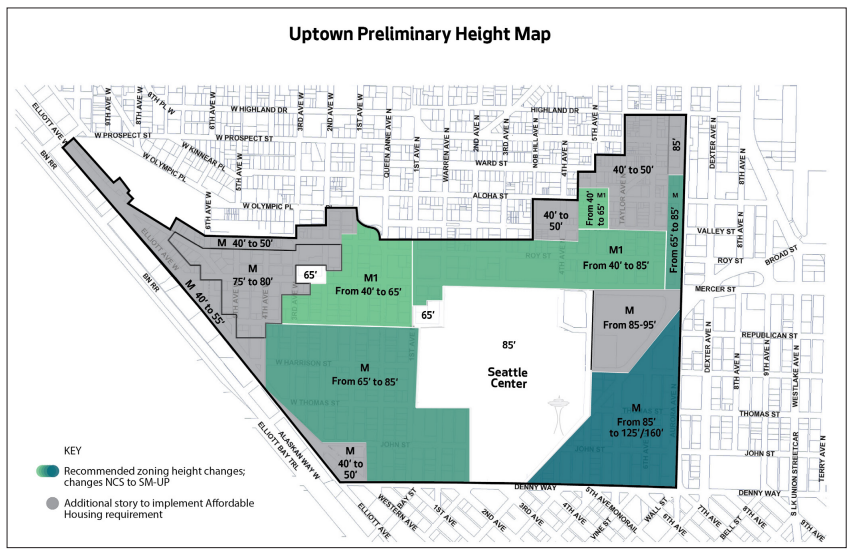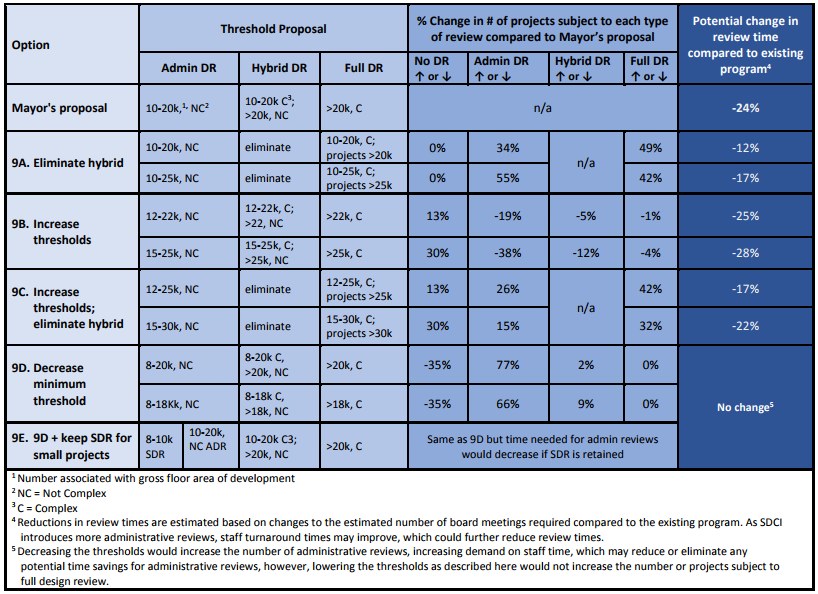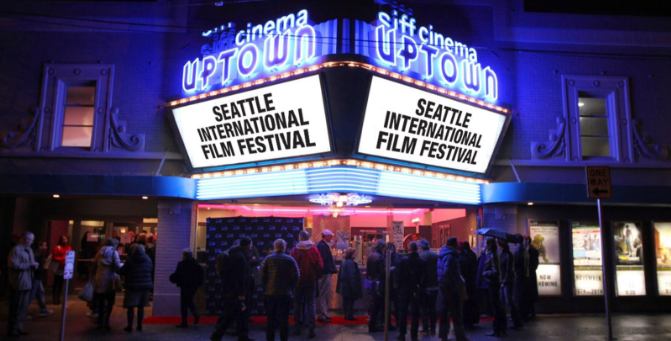The Seattle City Council is hosting a double feature at SIFF Cinema Uptown Auditorium 3 on Monday September 11. The first public hearing for the Uptown rezone will start at 5pm. The second will cover the design review improvement package and start at 7pm. We urge you to attend or contact your councilmembers in support of both pieces of legislation.
Putting the Up in Uptown’s Zoning

Seattle for Everyone has stressed the influx of affordable units expected from the rezone, which unlocks Seattle version of inclusionary zoning called the Mandatory Housing Affordability program: “Passage of the Uptown rezone would generate 600 new affordable homes over the next 20 years while also providing additional capacity for more housing overall.” Seattle for Everyone encourages testifiers at the public hearing to tell their personal story, seek to find common ground, and keep it brief to stay under time limits–good advice.
We’ve covered the Uptown rezone proposal both the zoning and development regulations. Much of the changes will be a relatively modest extra floor or two, although the southeast corner of Uptown could jump from 85 feet to as high as 160 feet, and a strip along Mercer Street could jump from Neighborhood Commercial 40 to 85, more than doubling its height limit and gaining a heightened M1 affordability requirement. The Seattle Center in the middle of the neighborhood has its own master plan, which includes a new high school and upgrading the Seattle Center Coliseum (commonly known as KeyArena) to a modernized facility.
Councilmember Rob Johnson has introduced potential amendments to further boost development capacity over the initial proposal.
- Amendment 1A deals with “The Heart of Uptown,” shorthand for the area surrounding Queen Anne Avenue N between Harrison and Roy streets. Mayor Ed Murray had proposed 65-foot Neighborhood Commercial zoning but Councilmember Johnson proposed to increase that to 85 feet and bumping floor area ratio (FAR) by .75 to a total of 5.25 FAR.
- Amendment 1B would increase Mercer/Roy corridor from 85 foot zoning to 125-foot zoning, with 1.75 additional FAR.
- Amendment 2A would increase the FAR incentive for art space and landmark preservation. Mayor Murray proposes a .5 FAR incentive, whereas Councilmember Johnson would increase that to 1.0 FAR incentive, likely attracting more applicants.
- Amendment 2B would add a FAR incentive for co-development of sites with Seattle Public Schools. Mayor Murray proposed exempting the square footage of the school from FAR calculation; Councilmember would go further and add a FAR incentive on top of that–similar to co-development regulations devised for South Lake Union.
- Amendment 2C would add a FAR or height incentive for development that meets family-friendly design standards, expanding to Uptown what the city council has already done in the U District and Downtown. The idea is that encouraging family-sized units and kid-friendly amenities would help more families reside in Seattle’s central core.
- Amendment 3A would reduce the average upper level setback requirement from 10 feet to 5 feet for portions of structure above 45 feet or 65 feet in height along Roy Street, Queen Anne Avenue, 1st Avenue, and 5th Avenue. The change would allow builders more flexibility, likely helping them squeeze a few more units into buildings.
- Amendment 4B would consider parking maximums for non-residential uses in Uptown, similar to the one space per 1,000 square feet rule for non-residential uses in Downtown and South Lake Union. Setting a non-residential parking maximum could help manage car traffic in Uptown. Some of us would even be interested in residential parking maximums!
Expanding development capacity in booming Uptown is a wise move, as is using stronger FAR incentives for socially responsible purposes like arts and public education. I support Councilmember Johnson’s amendments listed above; I encourage readers to work them into their comments.
Simplify Design Review
We’ve also covered the package of design review improvements the council is considering. I support raising the thresholds so fewer small and mid-sized projects need full review, instead providing hybrid or administrative review. If we want missing middle housing, we need to give it a viable path to be funded and built. Non-profit affordable housing provider Capitol Hill Housing found the hard way how aesthetic differences can delay worthy affordable projects–which in their case was mandated to maximize housing rather that spend money on frills.
“The situation is a perfect argument for the Mayor’s proposed changes to the design review program, which would allow affordable housing projects to go through the administrative design review process, speeding up the production of affordable homes in our city,” Capitol Housing Housing’s Ashwin Warrior said following the project’s delay.
The Seattle City Council is likely to take up some potential amendments, including the following:
- Amendment 3A would provide a departure of up to 10 feet and .5 FAR for saving an Exceptional Tree on site. The code departure would compensate the developer for lost development capacity from retaining the tree on site.
- Amendment 3B would allow Special Review Districts (such as those in Pioneer Square and Chinatown-International District) and Landmark Preservation Boards to grant land use code departures. This would prevent applicants from having to go through two separate review processes–adding time and costs–in order to get departures in these districts.
- Amendment 4A would allow projects that do the MHA performance option (building affordable units on-site) to go through a faster design review process. Projects performing on-site that would otherwise be subject to full design review would have the option to go through hybrid design review, and those subject to hybrid would have the option to be reviewed through administrative design review.
- Amendment 4B would extend the cap on number of design review meetings to projects with MHA units on-site even if they are requesting land use code departures. “This amendment would incentivize the MHA performance options by applying the proposed meeting caps to those projects even if the project is seeking departures,” Central Staff’s memorandum states.
- Amendment 5A would eliminate the proposed hybrid design review program, reasoning it’s another confusing change in the midst of many other changes. I’m curious, however if the pilot could provide a great avenue for bigger reforms down the road. Having a design board review projects first and then administrative staff go second for the recommendation phase seems promising and could lead to a smoother design approval model for most projects if it works well.
- Amendment 9 would make seemingly minor adjustments to design thresholds but Central Staff believes it could reduce review time by as much as 28% for some projects, which would be helpful. Amendment 9A would eliminate hybrid review, which doesn’t seem essential to the time savings and merits of which are debatable. Increasing the thresholds so that fewer projects trigger full review would be prudent, though.

Next steps: Streamlining the program and giving affordable projects a fast lane is a necessary step, but I hope that the council goes further to ensure that design feedback for all projects is given in a timely and fair fashion. That may involve making the land use codes that the boards must decipher simpler and reforming the structure of the design review boards themselves. Sightline has argued running the review board as neighborhood-based and all volunteers lends itself to inconsistencies, unreasonable hurdles from the boards themselves, and an empowered neighborhood opposition–and it appears some boards do get swayed to vocal opposition. Few cities run design review this way, and it’s costing Seattle homes.
The featured image is courtesy of SIFF Cinema Uptown.
Doug Trumm is publisher of The Urbanist. An Urbanist writer since 2015, he dreams of pedestrian streets, bus lanes, and a mass-timber building spree to end our housing crisis. He graduated from the Evans School of Public Policy and Governance at the University of Washington in 2019. He lives in Seattle's Fremont neighborhood and loves to explore the city by foot and by bike.



